| Faculty Index |  |
Answers the question:
How do the patterns of impure thought operate? |
Gray: Appetite
Lacks self-discipline |
White: Emotion
Practices self-deception |
Checkered: Intellect
Practices self-devotion |
The mind is a spiritual battleground where the patterns of impure thought resist godliness by resisting and/or corrupting pure ways of thinking. These conflicts take place in three areas: natural desires (via the appetites), discernment (via the emotions), and the ability to reason (via the intellect).Unlike the other indices, this index returns three values which measure relative degrees of weakness among fundamental human faculties.
When analyzing the three different values used for this index, remember that the first two values are calculated using three pattern scores, while the final value has only two components. Consequently, the "I" value is equal to roughly two-thirds of a comparable "A" or "E" value.
Each faculty responds best to specific remedies:
| Appetite | Emotion | Intellect |
| Pray for ... | ... purity so that your desires may be appropriate and moderate. | ... enlightenment so that you can discern and appreciate truth. | ... restraint so that you do not become arrogant. |
Emphasis in
ASPIRE | Abstain
Reflect
Examine | Intercede | Prayer
Study |
| Do ... | fast
practice restraint
submit to hardship
renounce your possessions
long for heaven
desire godliness | love
sympathize
be kind and gentle
show compassion
refuse to retaliate when wronged | have faith
embrace truth
study the Scriptures
pray ferventl
be grateful |
In 1 John 2:15-17, the Apostle John refers to three types of worldliness that correspond perfectly to this index. They are the lust of the eyes (Appetite), the lust of the flesh (Emotion), and the pride of life (Intellect).

| Gateway Index | 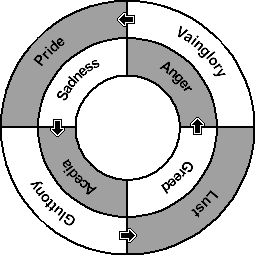 |
Answers the question:
Which patterns of impure thought deserve special attention? |
Gray: Follower
"Searching for something" and willing to experiment to find it |
White: Leader
No longer searching, but settled into a comfortable routine |
Some patterns lead, while others follow. White patterns "open the gate" and allow Gray patterns to enter and become established. In contrast, each Gray pattern tends to feed itself rather than encourage development elsewhere. For instance, unchecked gluttony eventually fuels or becomes lust, whereas lust most frequently leads to greater lust. The arrows in the diagram indicate the most common leader/follower relationships.Because of White's tendency to spread, success here is essential and necessary before victories over Gray are likely to be won.
It is important to watch out for all of the patterns; however, the "leader" patterns definitely create increased vulnerabilities to the "follower" patterns, making them especially dangerous. Evagrius cited only three such leader patterns (Gl Gr Va) which always came first, making it impossible to succumb to other five without first falling to one of the "Big Three." For example, he claimed it was impossible to fall to lust without first falling to gluttony.
I do not quite share his conviction regarding the absolute nature of the leader/follower relationships between the patterns. Thus I have added sadness to the "leader" category with the understanding that while acedia almost always follows sadness, it is not an absolute certainty. Having said all of this, the initial point remains -– the "leader" patterns warrant extra vigilance.
Several ancient authorities agree with Evagrius on the "Big Three" including John Climacus, Maximus the Confessor, John of Karpathos, John of Damascus, Thalassios the Libyan, Theodoros The Great Ascetic, Nikitas Stithatos, Gregory of Sinai, and others. See the comments on the Caution Index for a different perspective on the "Big Three."
At least one gateway pattern is present in each of the Faculty Index groupings.
When viewed as four groups of two, this index offers some additional insight into remedy: Gl Lu are deprived through self-control, Gr An are tamed through generosity, Sa Ac are purified through zeal, and Va Pr are corrected through humility.

| Provocation Index | 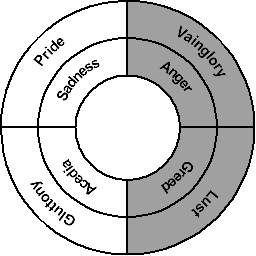 |
Answers the question:
What activates, arouses or provokes the patterns of impure thought? |
Gray: External
Places too much value on one's own desires |
White: Internal
Places too little value on what God desires |
Gray patterns almost always require an external (but not necessarily a physical) trigger. Lust, greed and anger typically have an object, while vainglory cannot take place in a vacuum. A persistent desire to acquire or attain something is convincing evidence that these thoughts are gaining ground.White patterns are more natural and internal. These thoughts can spring unbidden from within and do not require an external object to take root and grow. Rather than embracing something (as is the case with Gray), various forms of rejection are practiced instead.
At first glance, gluttony may not look like an internally provoked pattern, but it is actually a perversion of a natural desire that rejects restraint. The need for food is certainly internal. Gluttony is not externally provoked, but rather is externally manifested.
Envy, a prominent member of the list of seven deadly sins, does not appear as a separate entry in the PITscan, but it can be found here as a combination of the externally provoked (Gray) patterns.

| Manifestation Index | 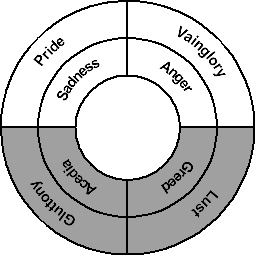 |
Answers the question:
What manner of conduct springs from the patterns of impure thought? |
Gray: External
Impulsive and unconcerned with what others think |
White: Internal
Deliberate and overly concerned with what others think |
This index is closely related to the Provocation Index. Once a pattern has been provoked, it inevitably moves beyond one's inner thought life and begins to influence both physical and mental forms of behavior.Gray patterns tend to initially produce more obvious, but not necessarily public, activity. This is in stark contrast to White patterns, which often lead to more reflective and private conduct. The former involves the senses (i.e., gluttony), but the latter can be committed while alone in a quiet, dark room (i.e., anger).
This index attempts to measure how someone commits to embarking on a course of sinful activity. They can be very deliberate (Gray) or quite rash (White) in coming to a point of decision. For example, a temper tantrum is an impulsive manifestation of anger, but lustful actions can be preceded by a lengthy period of anticipation before more concrete actions occur.

| Caution Index | 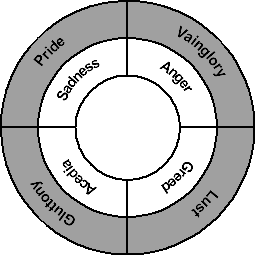 |
Answers the question:
How do the patterns of impure thought impact one's judgment? |
Gray: Impulsive
Willing to delay gratification to get maximum results |
White: Intentional
Seeks instant gratification, but unhappy with its results |
White patterns cause someone to be less cautious in their pursuit of satisfaction. Their behavior may actually hamper their ability to get what they want. For instance, an angry outburst may fail to produce the desired results, and make it even more difficult to attain their desired outcome.Gray patterns are characterized by a more deliberate, yet narrow, consideration of consequences. Any behavior that impedes "progress" towards an impure objective is carefully avoided. These patterns have an uncanny sense of self-preservation. For example, lustful thoughts rarely produce obstacles to further lustful thinking.
Unlike the Manifestation Index (which attempts to measure how one initiates a course of action), this index attempts to measure how one continues in that same course of action. One can be either quite deliberate or quite rash in their pursuit of satisfaction. For example, a person could rashly choose to covet something, yet pursue a deliberate manner of attaining it.
It is important to clarify how the concept of caution is being used within this index. Instead of referring to an awareness of the devastating power of sin (which would produce a godly and healthy caution), it refers to an awareness of things that may negatively impact their ability to satisfy their impure desires (which is a dangerous form of caution).
Much like Evagrius before him, Cassian also envisioned a group of leader patterns, but he proposed Gl Va Pr instead of Gl Gr Va. Citing the temptations of Adam and Christ as examples, he believed that Satan always attempts to enter first through one of these three patterns:
| Gluttony | Vainglory | Pride |
Adam
Gen 3:6 | "take and eat" | "your eyes will be opened" | "you will be like God" |
Christ
Lk 4:1-13 | "turn stones to bread" | "jump off the temple" | "worship me ..." |
Note: Evagrius thought the worship temptation of Christ was greed (" ... and I will give the whole world ...") rather than pride.
I mention this here because Cassian's "Big Three" is very similar to the Gray pattern set of this index.

| Moderation Index | 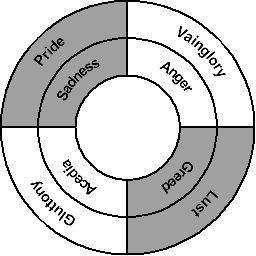 |
Answers the question:
How are the patterns of impure thought subdued or defeated? |
Gray: Tame
Insensitive and callous to certain sins ("I don't care if it's wrong.") |
White: Avoid
Wants to avoid certain sins, but struggles to do so ("I'd stop if I could.") |
White patterns are not always sinful; however, they are always dangerous. They have the potential to develop into impure thought, which can lead to ungodly behavior. For instance, there are righteous ways to be angry, but if it is not resolved in a timely manner it can quickly become impure anger. The problem with White patterns is excess. White says, "I know I shouldn't do it, but I can't stop."On the other hand, Gray patterns are always sinful. By definition, there simply are no godly forms of pride, sadness, greed or lust. Instead of taming these patterns (as is necessary with White), they should never even be entertained. Gray says, "I know it's wrong, but I don't care."
Since the pattern definitions used throughout the PITscan are substantially different than common usage, it might be helpful to review the pattern definitions while considering this index. For example, pride (by definition) is a declaration of independence from God. Because this is never acceptable, it belongs in the Gray category. But what about a father saying that he is proud of his son? Is that a sin? No, it is not, because that is not really an expression of pride (again, by definition). He is actually pleased with son and has expressed pleasure, not pride.
Similarly, sadness is dissatisfaction with God and never includes godly sorrow or bereavement. Greed is never an example of good stewardship. Lust has absolutely nothing to do with appropriate spousal affection. The Gray patterns are always wrong.
White patterns are typically problems of excess. For instance, overeating is a common form of gluttony, but the sin is not in the act, but the excess. Likewise, the restfulness of acedia is necessary, but not in excess. Anger can be expressed correctly. To acknowledge the personal possession of a skill, talent, or resource can be done with honesty and humility rather than vanity. It is possible to correct the White patterns. In some situations, the outward behavior would be acceptable if only the inward attitudes were adjusted.

| Activity Index | 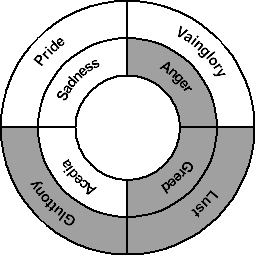 |
Answers the question:
Where do the patterns of impure thought ultimately lead? |
Gray: More
Increasing level of activity in quest for satisfaction |
White: Less
Decreasing level of activity as dissatisfaction intensifies |
This index builds upon the Gateway Index by showing how the patterns are components of two continual, self-sustaining processes. In the Gray progression, legitimate needs (gluttony) become illegitimate desires (lust), and as efforts to fulfill these desires (greed) fail to bring lasting peace, intense frustration develops (anger). Similarly, the White progression starts with feelings of superiority (vainglory) that turn into feelings of independence (pride), which produces loneliness and dissatisfaction (sadness) that eventually becomes a crippling apathy (acedia).Both progressions lead to enslavement and, ultimately, destruction.
Cassian addressed the issue of pattern progression by placing the first six patterns into one category and the remaining two in another. He taught that each pattern was dependent on the ones preceding it (1 led to 2 which led to 3, etc.). One path to victory would be to address the prior patterns (attack 5 for assistance in fighting 6). This 1-6 progression works in both directions. [Note: Cassian chooses to swap anger and sadness in his ordering of the patterns.]
However, vainglory and pride (7-8) belong in a separate category because vulnerabilities to them were created by attaining victory against any of the other patterns. Accordingly, a victory against 6 makes one weaker against 7 (not stronger, as one might suspect).
The Activity Index is very similar to Cassian's categories mentioned above, yet attempts to measure activity, instead of victory conditions. Interestingly, anger can lead to sadness, at which point the Gray pattern progression merges into White.

| Identification Index | 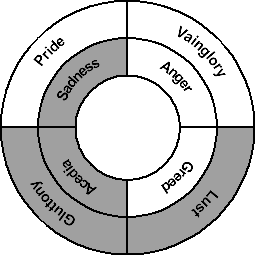 |
Answers the question:
How are the patterns of impure thought identified? |
Gray: External
Recognizes own repeated failures and needs to hear good counsel |
White: Internal
Denies own repeated failures and needs to heed good counsel |
White patterns thrive in the "blind spot." Those who have fallen here either refuse to recognize their failure, or they dismiss it as unimportant. For example, someone might justify losing their temper as acceptable due to extenuating circumstances, instead of believing it to be an act of ungodliness. While it is difficult to see these patterns in one's self, it is much easier to recognize them as sinful in others.Gray patterns are more readily self-recognized. Those who struggle with gluttony, lust or sloth are especially aware of their problem, but they often feel powerless to correct it.
Evagrius saw two kinds of demons which tempt man: those who appeal to the rational part of man, and those who appeal to the non-rational part (Thoughts 18). The White patterns are identical to the rational temptations, but the Gray patterns are not exclusively irrational. There is a layer of significance to this index that currently eludes me.

| Impediment Index | 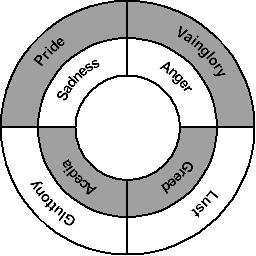 |
Answers the question:
How do the patterns of impure thought impede the pursuit of God? |
Gray: Distort
Deliberately chooses to neglect the spiritual disciplines |
White: Distract
Tries to practice the spiritual disciplines, but struggles to do so |
Gray patterns hinder spiritual growth by causing one to undervalue the spiritual disciplines (such as prayer, Scripture reading, fasting, meditation, etc.) because they are perceived to be either unnecessary or ineffective.White patterns tend to hinder spiritual growth by erecting obstacles to the practice of the spiritual disciplines. One is likely to either forget to do them or to be fairly easily distracted while trying to do them. This, in turn, can lead to feelings of guilt and/or inadequacy which discourage future attempts at discipline.
Spiritual immaturity or naivety appears to be a contributing factor in the White patterns, and is correctable through growth. The Gray patterns are more often evidence of "carnal maturity."
This index might also be called the Nature Index. Gray patterns are unnatural and must be granted admittance before they can take root. This can happen through either carelessness or bad habit. White patterns more closely resembles fire or iron, which are intrinsically amoral. These natural desires are perverted into something dangerous and put to inappropriate uses.
Both sets of patterns can be broken down into two further subcategories:
Gray
Distort | arrogant (Ac Pr)
"I don't need this." | skeptical (Gr Va)
"It doesn't work." |
White
Distract | forgetful(Gl Sa)
"Oops." | distracted (Lu An)
"Where was I?" |

| Relationship Index | 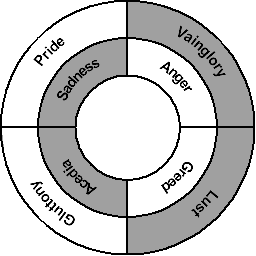 |
Answers the question:
How do the patterns of impure thought impact my relationships with others? |
Gray: Unavailable
Resists the practice of reasonable restraint and acts unpredictably |
White: Unreliable
Resists being instructed or corrected |
White patterns are a part of mankind's fallen nature. Men are born capable of behavior which is in the spirit of these patterns. The focus is on one's self with little consideration given to the negative impact that poor choices will have on others.Gray patterns are acquired through exposure and "perfected" through imitation and practice. There is an awareness of others, but the focus remains on self as they are merely seen as a means to the end of personal satisfaction.
Community standards can play a role in determining if certain behaviors are right or wrong. This is especially true of the Gray patterns which contain a strong cultural component. What encourages sinful behavior in one culture may not necessarily achieve the same results in another. For example, a man looking at a woman's unbound hair can cause problems in certain cultures, but not in others. However, not all Gray behavior is relative to culture, as there are some acts which are universally sinful, such as adultery.
White patterns tend to be more acultural. For example, outbursts of anger look pretty much the same everywhere.










No comments:
Post a Comment